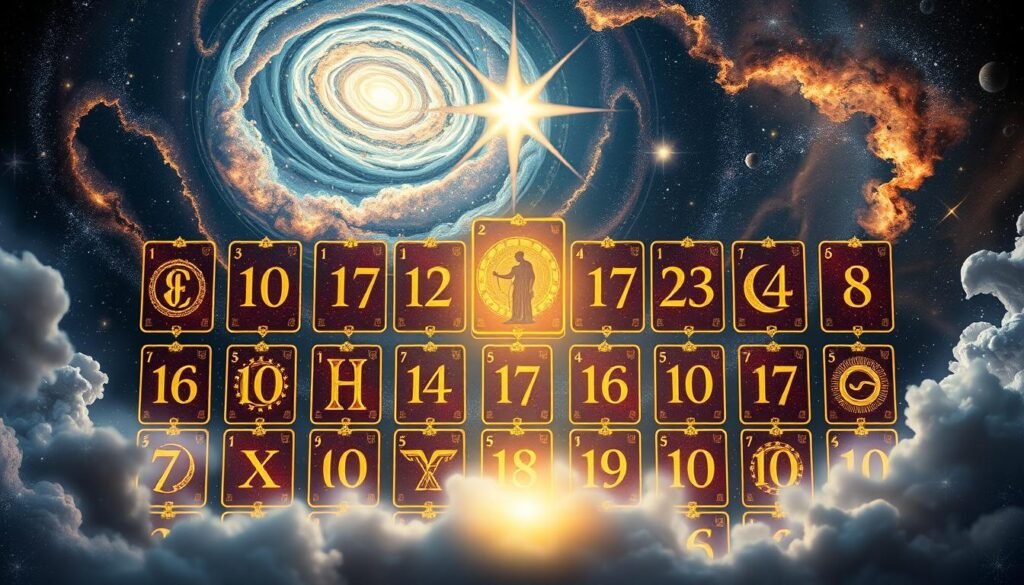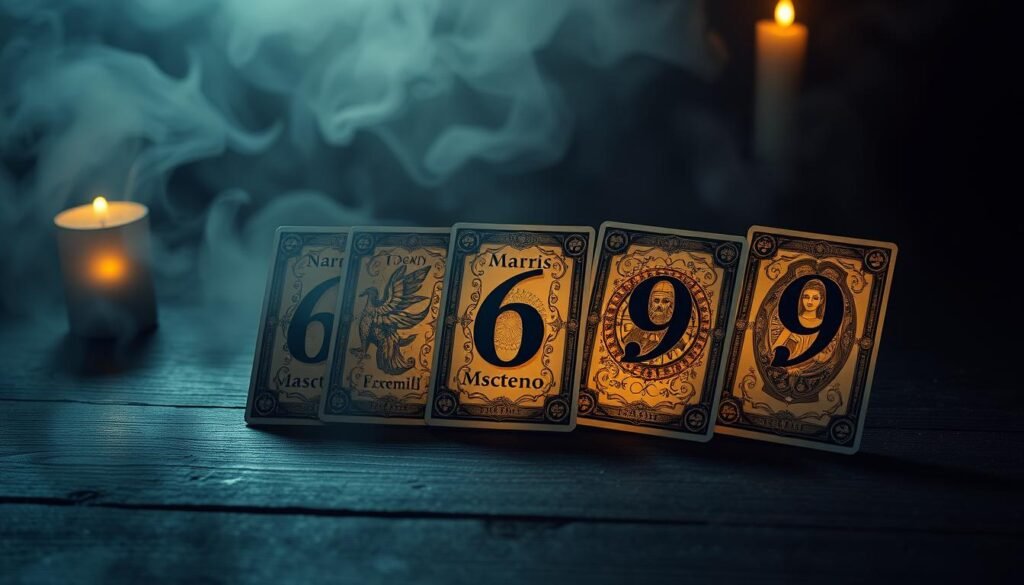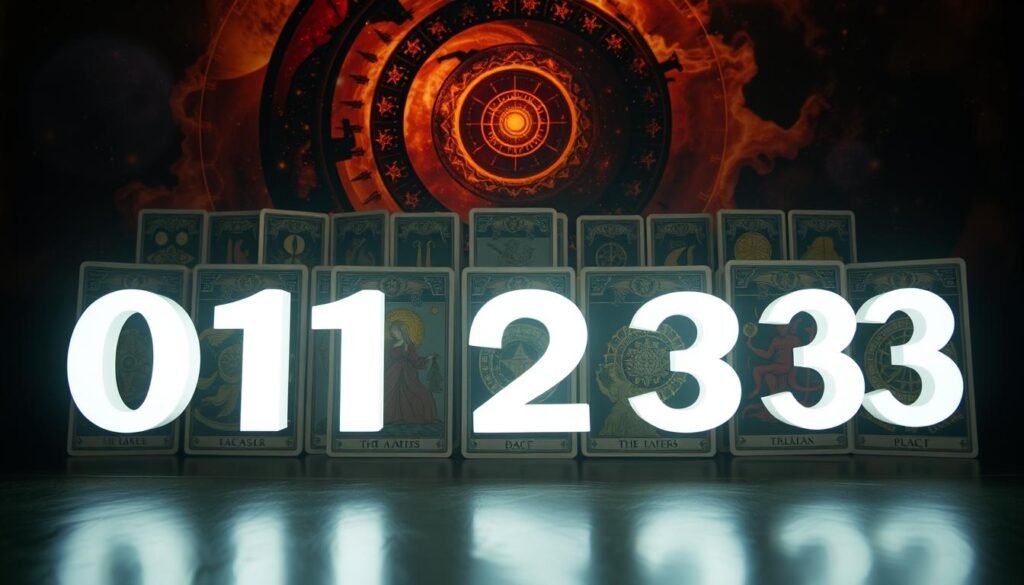We delve into the mysterious world of Tarot Cards and uncover the hidden Numerology Secrets within the Major Arcana. The Major Arcana is a complex and intriguing part of the Tarot deck, holding deep symbolic meanings and connections to numerology.
For centuries, Tarot cards have been used for divination and self-reflection, with the Major Arcana being a crucial component. We explore the historical origins of Tarot and numerology, understanding how these two systems are intertwined.
By examining each of the Major Arcana cards and their numerological significance, we gain a deeper understanding of their influence on Tarot readings.
Key Takeaways
- Understanding the historical origins of Tarot and numerology.
- Exploring the connection between Tarot cards and numerology.
- Discovering the numerological significance of Major Arcana cards.
- Learning how Major Arcana cards influence Tarot readings.
- Gaining insights into the symbolic meanings of Tarot cards.
The Ancient Connection Between Tarot and Numerology
The mystical realms of Tarot and Numerology have long been intertwined, sharing a rich history that spans centuries. This connection is not merely coincidental; it is rooted in the belief that numbers hold the key to understanding the universe and our place within it.
The Historical Origins of Tarot and Numerology
Tarot and Numerology have their roots in ancient cultures, where numbers were considered sacred and believed to possess mystical properties. The earliest recorded use of Tarot dates back to the 15th century in Italy, while Numerology has its roots in ancient Greece and Egypt, where philosophers like Pythagoras explored the mystical significance of numbers.
The evolution of these systems over time has led to a rich tapestry of symbolism and meaning, with both Tarot and Numerology influencing each other in profound ways.
Why the Number 22 Is Significant in Both Systems
The number 22 is particularly significant in both Tarot and Numerology. In Tarot, there are 22 Major Arcana cards, each representing a major life theme or archetype. In Numerology, 22 is considered a Master Number, symbolizing balance, harmony, and the manifestation of dreams into reality.
This dual significance underscores the deep connection between Tarot and Numerology, highlighting the importance of the number 22 in understanding the complexities of the human experience.
Understanding the 22 Major Arcana as a Numerological System
The numerological system underlying the 22 Major Arcana provides a rich framework for understanding the Tarot’s symbolic language. As we delve into the Major Arcana cards, we notice that each card is not only rich in symbolism but also deeply connected to a numerological sequence. This sequence is fundamental to understanding the progression and meaning of the cards.

The numerological progression of the Major Arcana is often associated with the Fool’s Journey, a metaphorical path that the querent or the seeker embarks upon. This journey is not just a random sequence of events or symbols; it is a carefully structured progression that reflects various stages of human experience and spiritual growth.
The Fool’s Journey as a Numerological Progression
The Fool’s Journey through the Major Arcana is a powerful narrative that encapsulates the human experience, from the innocence and potential of the Fool (0) to the completion and fulfillment of The World (21). Numerologically, this journey represents a progression from 0 to 21, where each number holds a specific significance and contributes to the overall story.
- The initial cards (0-7) represent the initial stages of the journey, focusing on personal growth and external experiences.
- The middle cards (8-14) signify challenges, transformations, and the development of inner strength.
- The final cards (15-21) represent the later stages of the journey, where the individual achieves higher states of consciousness and understanding.
How Tarot Numbers Influence Card Meanings
The numbers associated with the Major Arcana cards significantly influence their interpretations. For instance, the number 1, associated with The Magician, signifies creation, manifestation, and personal power. In contrast, the number 13, associated with Death, represents transformation, change, and renewal.
Understanding the numerological significance of each card can enhance Tarot readings by providing deeper insights into the symbolism and themes present in the cards.
The Single Digit Cards (0-9) and Their Numerology
The single-digit cards in the Major Arcana hold the key to understanding the fundamental principles of Tarot numerology. These cards, numbered from 0 to 9, form the foundation upon which the rest of the Tarot system is built. By examining each of these cards and their numerological significance, we can gain a deeper understanding of the Tarot’s symbolism and how it applies to our lives.

The Fool (0): The Infinite Potential
The Fool, numbered 0, represents the infinite potential that lies at the beginning of any journey. This card is about new beginnings, innocence, and the willingness to take risks.
Numerological Significance of Zero in Tarot
In numerology, the number 0 is considered a symbol of the void and infinite potential. It signifies the starting point of a journey, where all possibilities are open.
The Magician (1): The Power of Creation
The Magician, numbered 1, embodies the power of creation and manifestation. This card is about skill, manifestation, and personal power.
Number One as the Divine Masculine
The number 1 is often associated with the divine masculine, representing action, initiative, and leadership. It signifies the ability to manifest one’s desires into reality.
The High Priestess (2): Duality and Balance
The High Priestess, numbered 2, represents duality and balance. This card is about intuition, wisdom, and the subconscious.
Number Two as the Divine Feminine
The number 2 is associated with the divine feminine, symbolizing receptivity, harmony, and balance. It represents the yin to the yang of the number 1.
The Empress (3): Creative Expression
The Empress, numbered 3, is the embodiment of creative expression and abundance. This card is about fertility, creativity, and the manifestation of one’s desires.
Number Three as the Triangle of Manifestation
The number 3 is considered a sacred number, representing the triangle of manifestation. It signifies the union of the divine masculine and feminine, resulting in creation.
The Emperor (4): Structure and Stability
The Emperor, numbered 4, represents structure and stability. This card is about authority, leadership, and the establishment of order.
Number Four as the Foundation of Reality
The number 4 is associated with the foundation of reality, representing the four elements and the four directions. It signifies stability and practicality.
The Hierophant (5): Spiritual Guidance
The Hierophant, numbered 5, is a symbol of spiritual guidance and tradition. This card is about conformity, spiritual guidance, and the search for meaning.
Number Five as Change and Adaptation
The number 5 represents change and adaptation, signifying the need to be flexible and adjust to new circumstances. It is a number of freedom and adventure.
The Single Digit Cards Continued (6-9)
The single-digit cards from 6 to 9 hold profound insights into various aspects of our lives, as revealed through their Tarot interpretations and numerological themes. As we explore these cards, we gain a deeper understanding of the complexities of human experience and the numerological principles that underlie the Tarot system.

The Lovers (6): Harmony and Relationships
The Lovers card, numbered 6, symbolizes harmony, relationships, and choices. It represents the union of opposites and the decisions we make in the name of love and partnership.
Number Six as Balance and Responsibility
Numerologically, the number 6 is associated with balance, responsibility, and nurturing energy. It signifies the importance of creating harmony in our relationships and taking responsibility for our choices.
The Chariot (7): Determination and Willpower
The Chariot, numbered 7, embodies determination, willpower, and control. It represents our ability to overcome obstacles and achieve our goals through sheer determination.
Number Seven as Spiritual Victory
The number 7 is often seen as a spiritual number, representing victory over the self and the attainment of spiritual knowledge. It signifies a deep understanding of the world and our place within it.
Strength (8): Courage and Inner Power
The Strength card, numbered 8, represents courage, inner power, and self-discipline. It symbolizes our capacity to face challenges with grace and to tame our inner beasts.
Number Eight as Infinity and Abundance
Numerologically, the number 8 is associated with infinity and abundance, representing the infinite possibilities available to us and the abundance that comes from living in balance.
The Hermit (9): Wisdom and Introspection
The Hermit, numbered 9, signifies wisdom, introspection, and solitude. It represents the need to withdraw from the world to gain a deeper understanding of ourselves and our life’s journey.
Number Nine as Completion and Wisdom
The number 9 is considered a number of completion, representing the culmination of our experiences and the wisdom gained along the way. It signifies a stage of near-completion and the preparation for a new cycle.
The Master Numbers in the 22 Major Arcana
As we explore the 22 Major Arcana, we encounter Master Numbers that hold significant numerological importance. These numbers are considered to possess higher spiritual significance and are found in cards that are pivotal to the Tarot’s symbolic language.

Justice (11): Balance and Karmic Law
The Justice card, numbered 11, is associated with the Master Number 11, known for its connection to spiritual awakening and enlightenment. Master Number 11 is considered a powerful and sacred number, symbolizing balance, harmony, and karmic justice.
The Power of Master Number 11
Master Number 11 is often referred to as the “Spiritual Awakening” number, signifying a deep connection to the spiritual realm and heightened intuition. It represents the ability to see beyond the physical world and understand the deeper laws that govern our lives.
The Hanged Man (12): Surrender and New Perspective
The Hanged Man, numbered 12, represents sacrifice and new perspectives. When we reduce 12 to a single digit (1+2), we get 3, indicating the creative expression that can arise from surrender.
Number 12 as 1+2 = 3: Sacrifice for Creation
The reduction of 12 to 3 signifies the transformation of sacrifice into creative output. This numerological theme highlights the importance of letting go to create something new.
Death (13): Transformation and Rebirth
The Death card, numbered 13, is associated with transformation and rebirth. Reducing 13 to a single digit (1+3) gives us 4, symbolizing stability and structure.
Number 13 as 1+3 = 4: Transformation into Stability
The numerological reduction of 13 to 4 indicates that transformation leads to stability. This theme is central to understanding the Death card’s role in the Tarot.
Temperance (14): Moderation and Harmony
Temperance, numbered 14, represents moderation and balance. When reduced (1+4), we get 5, signifying change and dynamic movement.
Number 14 as 1+4 = 5: Balancing Change
The reduction of 14 to 5 highlights the dynamic balance between stability and change. Temperance teaches us to navigate these elements harmoniously.
Understanding these Master Numbers and their reductions provides a deeper insight into the Tarot’s complex symbolism, allowing us to appreciate the intricate numerological themes present in the 22 Major Arcana.
The Higher Vibration Cards (15-18)
Exploring the higher vibration cards reveals the intricate connection between Tarot and Numerology. As we journey through the Major Arcana, cards 15 to 18 present themes that are both challenging and transformative. These cards symbolize significant aspects of human experience and spiritual growth.

The Devil (15): Material Bondage and Liberation
The Devil card represents the shadow self, where material bondage and liberation are intertwined. It signifies the aspects of our lives where we feel trapped or limited.
Number 15 as 1+5 = 6: The Shadow of Harmony
Numerologically, The Devil card reduces to 6, a number associated with harmony and balance. This suggests that our perceptions of bondage are often a shadow reflection of our own disharmony.
The Tower (16): Sudden Change and Awakening
The Tower is a card of sudden, profound change, often representing upheaval or revelation. It signifies the breaking down of old structures to make way for new growth.
Number 16 as 1+6 = 7: Destruction for Spiritual Growth
Reducing to 7, a number associated with spiritual growth and introspection, The Tower’s message is one of destruction that leads to spiritual awakening.
The Star (17): Hope and Inspiration
The Star is a beacon of hope, inspiration, and positive energy. It represents the calm after the storm, symbolizing peace and serenity.
Number 17 as 1+7 = 8: Infinite Hope
Numerologically, The Star reduces to 8, a number of balance and infinite possibility, underscoring the card’s message of enduring hope.
The Moon (18): Intuition and Subconscious
The Moon card delves into the realm of intuition and the subconscious, representing the mysterious and the unknown. It calls for trust in our inner wisdom.
Number 18 as 1+8 = 9: Completing the Subconscious Journey
Reducing to 9, a number that signifies completion and humanitarianism, The Moon’s numerological significance highlights the culmination of our subconscious journey.
In conclusion, the higher vibration cards of the Major Arcana offer deep insights into our spiritual journeys and personal growth. By understanding their numerological significance, we can unlock the deeper meanings behind these powerful Tarot cards.
The Completion Cards (19-21)
As we explore the final cards of the Major Arcana, we discover that The Sun, Judgment, and The World are intricately connected through their numerological significance. These cards represent the culmination of the journey through the Major Arcana, embodying themes of completion, rebirth, and fulfillment.

The Sun (19): Joy and Vitality
The Sun card, numbered 19, radiates joy and vitality. Its numerological significance is revealed when we reduce 19 to its root numbers: 1+9 = 10, and further, 1+0 = 1.
Number 19 as 1+9 = 10 = 1: New Beginnings in Light
This reduction to the number 1 signifies new beginnings, illuminated by the light of understanding and awareness. The Sun represents a state of being where one is enlightened and full of life, marking a significant point in one’s journey.
Judgment (20): Rebirth and Awakening
The Judgment card, numbered 20, symbolizes rebirth and awakening. Numerologically, 20 reduces to 2+0 = 2.
Number 20 as 2+0 = 2: Duality of Judgment
The number 2 represents duality, highlighting the card’s theme of making choices and facing the consequences of one’s actions. Judgment calls for self-reflection and a deeper understanding of one’s path.
The World (21): Completion and Fulfillment
The World card, numbered 21, embodies completion and fulfillment. When we break down 21 numerologically, we get 2+1 = 3.
Number 21 as 2+1 = 3: Creating Wholeness
The number 3 is associated with creativity and manifestation. The World represents the integration of different aspects of the self, leading to a state of wholeness and fulfillment.
Practical Applications of the 22 Major Arcana Numerology
As we explore the practical applications of the 22 Major Arcana numerology, we discover new ways to enrich our Tarot readings. By understanding the numerological themes associated with each card, we can gain deeper insights into the symbolism and meaning behind the cards.
Using Numerology to Enhance Tarot Readings
Numerology can significantly enhance our Tarot readings by providing an additional layer of interpretation. For instance, when we encounter a card like The Magician (1), we can consider the numerological significance of the number 1, which represents creation, manifestation, and individuality. This understanding can help us interpret the card’s message more effectively, whether it appears in a reading as a call to action or as a representation of the querent’s current state.
When interpreting Tarot cards, we can use numerology to:
- Understand the underlying themes and energies of the cards
- Identify patterns and connections between cards in a spread
- Gain insight into the querent’s personality, challenges, and opportunities
Personal Year Cards and Life Path Connections
Another practical application of numerology in Tarot is the concept of Personal Year Cards and Life Path Connections. By calculating an individual’s Personal Year Number, we can determine which Major Arcana card corresponds to their current year, offering insights into the themes and challenges they may face during that year.
For example, if someone’s Personal Year Number is 5, corresponding to The Hierophant, they may be entering a period of spiritual exploration or seeking guidance from tradition or authority figures. Understanding this connection can help us provide more targeted and meaningful Tarot readings.
By integrating these numerological insights into our Tarot practice, we can offer more nuanced and personalized guidance to those seeking our advice.
Conclusion
Our exploration of the 22 Major Arcana Tarot cards and their numerology secrets has revealed the profound connections between these ancient systems. By understanding the numerological themes and significance of these cards, we can enhance our Tarot practice and gain a deeper appreciation for the symbolic language of the Tarot.
The integration of Tarot and Numerology offers a more comprehensive understanding of the 22 Major Arcana, allowing us to uncover the hidden patterns and meanings within the cards. As we’ve seen, each card’s numerological significance adds depth to its interpretation, from the infinite potential of The Fool (0) to the completion and fulfillment of The World (21).
By applying the principles of Tarot and Numerology, we can enrich our understanding of the 22 Major Arcana and improve our Tarot readings. Whether you’re a seasoned Tarot reader or just beginning your journey, the insights gained from this exploration can help you navigate the complex symbolism of the Tarot with greater ease and confidence.

